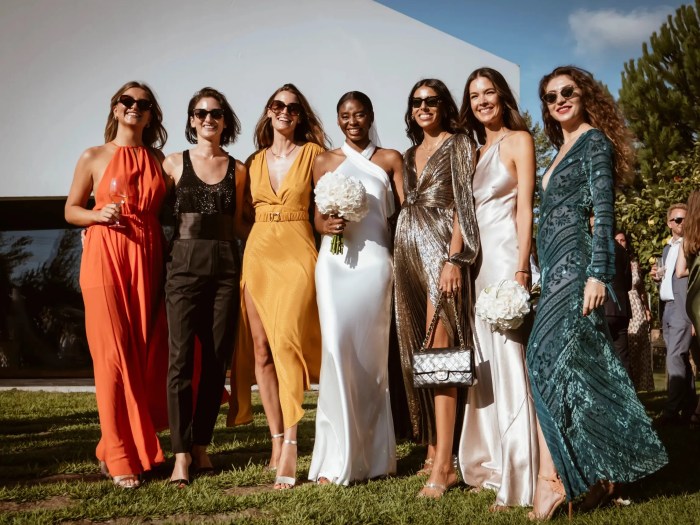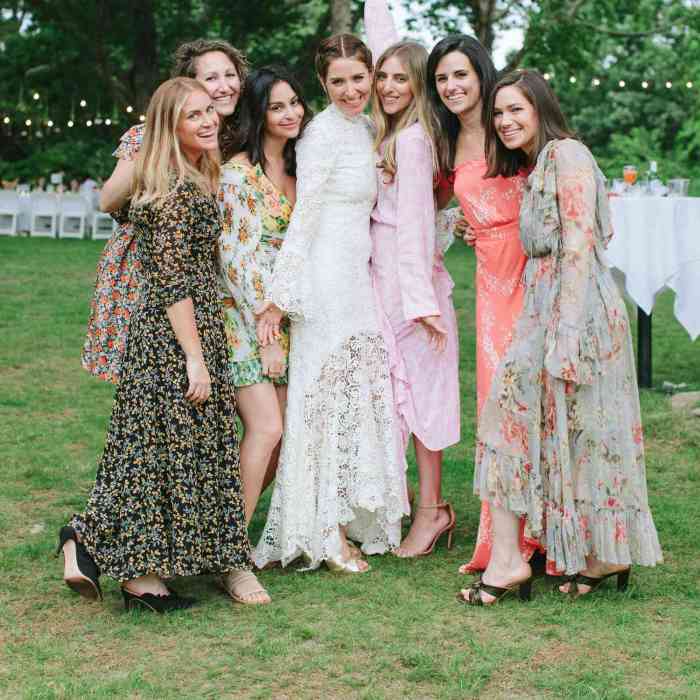Structured Dress for Wedding Guest A Style Guide
Structured Dresses for Wedding Guests: Structured Dress For Wedding Guest
Structured dress for wedding guest – Choosing the perfect outfit for a wedding can be a daunting task, especially when navigating the nuances of dress codes and personal style. A structured dress offers a sophisticated and versatile option, capable of adapting to various wedding settings and formality levels. This guide explores the key aspects of selecting and styling a structured dress for a wedding guest, ensuring you look and feel your best while celebrating the happy couple.
Defining “Structured Dress” for Wedding Guests

Source: vogue.com
Structured dresses are characterized by their defined silhouette, created through tailored construction and supportive fabrics. Unlike flowing or loose-fitting dresses, structured dresses maintain their shape, offering a polished and elegant appearance. This is achieved through elements like boning, internal structure, or stiff fabrics. They differ from other dress styles such as bohemian dresses (flowy, often with lace or embroidery) or casual sundresses (lightweight, simple design).
Common fabrics include brocade, crepe, taffeta, silk, and structured jersey. These materials provide body and hold their shape well, contributing to the dress’s overall structured look.
Silhouettes range from classic A-line and sheath styles to more contemporary fits and flares. A-line dresses offer a flattering, universally appealing shape, while sheath dresses provide a sleek, form-fitting silhouette. Structured dresses can also incorporate peplums, high-low hems, or other design details to create visual interest and enhance the overall structure.
Appropriate Levels of Formality
The appropriateness of a structured dress depends heavily on the wedding’s formality level. A simple crepe sheath dress might be suitable for a casual daytime wedding, while a richly embellished brocade gown would be more appropriate for a black-tie affair. A beach wedding calls for a lighter fabric and a less structured silhouette, perhaps a structured cotton or linen dress with a relaxed fit.
| Wedding Style | Venue | Appropriate Structured Dress | Accessories |
|---|---|---|---|
| Black-Tie | Formal Ballroom | Floor-length gown in silk or brocade, with embellishments | Statement jewelry, elegant clutch, heels |
| Semi-Formal | Country Club, Garden | Midi-length dress in crepe or silk, with subtle detailing | Delicate necklace, small handbag, mid-heeled shoes |
| Casual | Beach, Backyard | Knee-length or midi dress in cotton or linen, with a relaxed fit | Minimal jewelry, straw bag, sandals or wedges |
| Cocktail | Hotel, Restaurant | Knee-length or midi dress in a structured jersey or ponte knit | Statement earrings, small clutch, heels or elegant flats |
Color and Pattern Considerations

Source: brides.com
Color plays a significant role in the overall impression of a structured dress. Deep jewel tones (emerald, sapphire, ruby) convey elegance and sophistication, while pastels (blush, mint, lavender) offer a softer, more romantic feel. Brighter colors can be cheerful and celebratory, but should be chosen carefully to avoid clashing with the wedding’s color scheme. Seasonal considerations are also important; richer tones are suitable for fall and winter weddings, while lighter shades are more appropriate for spring and summer events.
Patterns, such as floral prints, geometric designs, or subtle embellishments, can add visual interest to a structured dress. However, it’s essential to consider the level of formality. Bold prints might be suitable for a casual wedding, but a more subdued pattern or solid color is generally preferred for formal occasions. Overly busy patterns can detract from the elegance of a structured silhouette.
Fabric and Design Details
The choice of fabric significantly impacts the drape, comfort, and overall look of a structured dress. Crepe offers a smooth, sophisticated drape, while taffeta provides a more structured, lustrous finish. Silk is luxurious and elegant, but requires careful care. Structured jersey is comfortable and forgiving, ideal for less formal settings. The selection should consider the weather, body type, and personal preference.
A heavier fabric might be too warm for a summer wedding, while a lighter fabric may lack the necessary structure for a formal event.
Key design elements that contribute to the structured look include a well-defined neckline (e.g., bateau, boat neck, sweetheart), structured sleeves (e.g., puff sleeves, bell sleeves, cap sleeves), and a defined waistline. These elements create shape and enhance the overall silhouette.
- Clean lines and minimal embellishments
- Well-defined waistline
- High-quality fabric with good drape
- Subtle detailing such as pleats or darts
- A flattering neckline and sleeve length
Styling and Accessories, Structured dress for wedding guest
Accessorizing a structured dress involves carefully considering the overall look and level of formality. Jewelry choices should complement the dress and the wedding’s setting. A statement necklace might be suitable for a semi-formal wedding, while delicate earrings and a bracelet are more appropriate for a black-tie event. Handbags should be proportionate to the dress and the occasion; a small clutch is ideal for formal events, while a larger tote bag might be suitable for a casual wedding.
Hair and makeup should complement the dress and the overall style. An updo can be elegant and sophisticated, while loose waves can create a more relaxed look. Makeup should be appropriate for the time of day and the formality of the event; a natural look is suitable for a daytime wedding, while a more glamorous look is appropriate for an evening event.
Choosing the right undergarments is crucial; a well-fitting bra and shapewear can enhance the silhouette and create a smooth, polished look.
Finding the Perfect Fit
Proper fit is paramount for a structured dress. A well-fitting dress will flatter the figure and enhance the overall look. If alterations are needed, a skilled tailor can adjust the dress to ensure a perfect fit. This may involve adjusting the length, waistline, or other areas to create a more flattering silhouette. Choosing the right size and style based on body shape is essential; A-line dresses are universally flattering, while sheath dresses are best for those with a more defined waistline.
Consider your body shape when selecting a structured dress. If you have a pear-shaped body, an A-line dress will balance your proportions. If you have an hourglass figure, a sheath dress will accentuate your curves. If you have a rectangular figure, a dress with a defined waist will create more shape. Remember that the goal is to choose a dress that makes you feel confident and comfortable.
FAQ
What undergarments are best for a structured dress?
Seamless, smoothing undergarments are ideal to avoid visible lines under the structured fabric. Consider a body shaper or a well-fitting bra and underwear set that won’t create bumps or show through the dress.
How do I choose the right sleeve length for a structured dress?
Sleeve length depends on the season and the wedding’s formality. Sleeveless or short sleeves are suitable for warmer weather and less formal events, while longer sleeves are appropriate for cooler temperatures and more formal weddings.
Can I wear a structured dress to a casual wedding?
Yes, but choose a less formal style in a lighter fabric and color. Avoid overly structured or embellished dresses for casual weddings. Opt for a simpler silhouette and less dramatic accessories.
Choosing a structured dress for a wedding guest offers a sophisticated yet comfortable option. If you’re looking for inspiration, the aesthetic of simple romantic wedding dresses often features elegant silhouettes that could inform your choice. Ultimately, a well-structured dress ensures you’ll feel confident and appropriately dressed for the celebration, complementing the overall wedding atmosphere.
What if my structured dress doesn’t fit perfectly?
Professional alterations are highly recommended to ensure a flattering fit. A tailor can adjust the length, waist, or other areas to create a perfect silhouette.



















